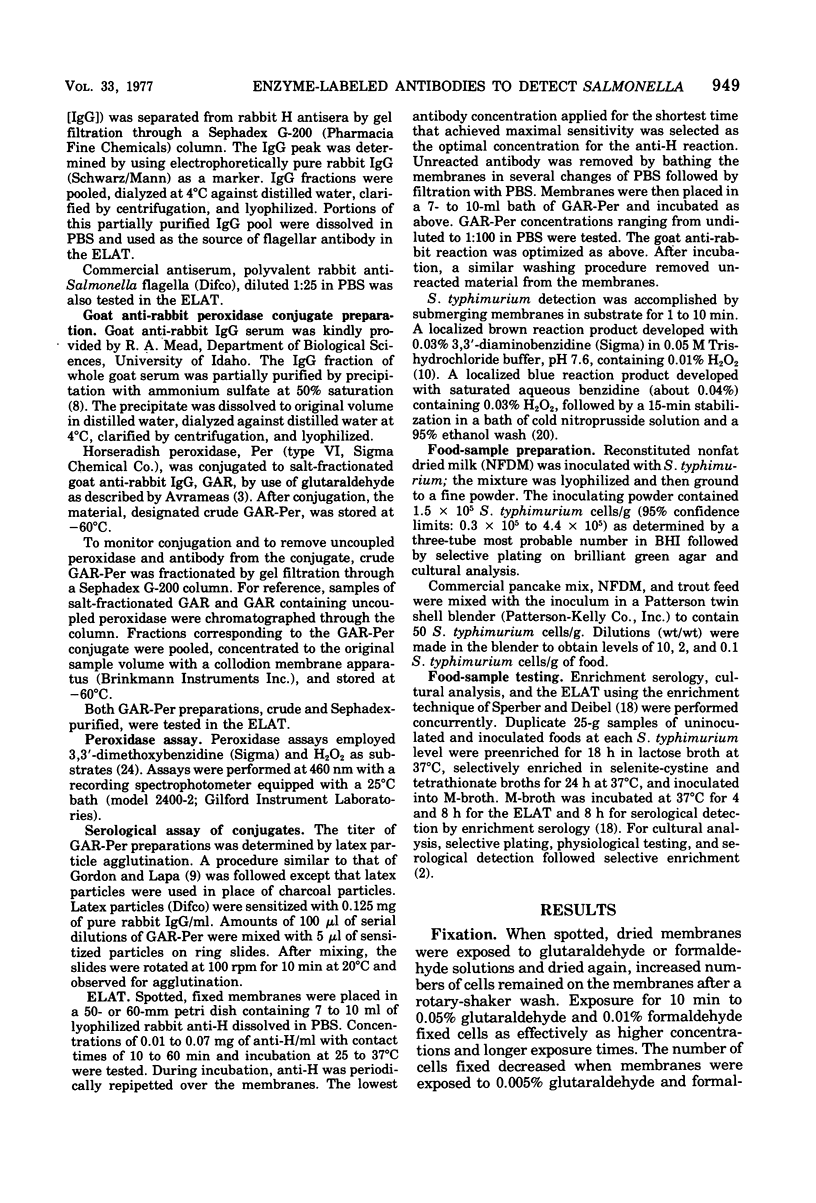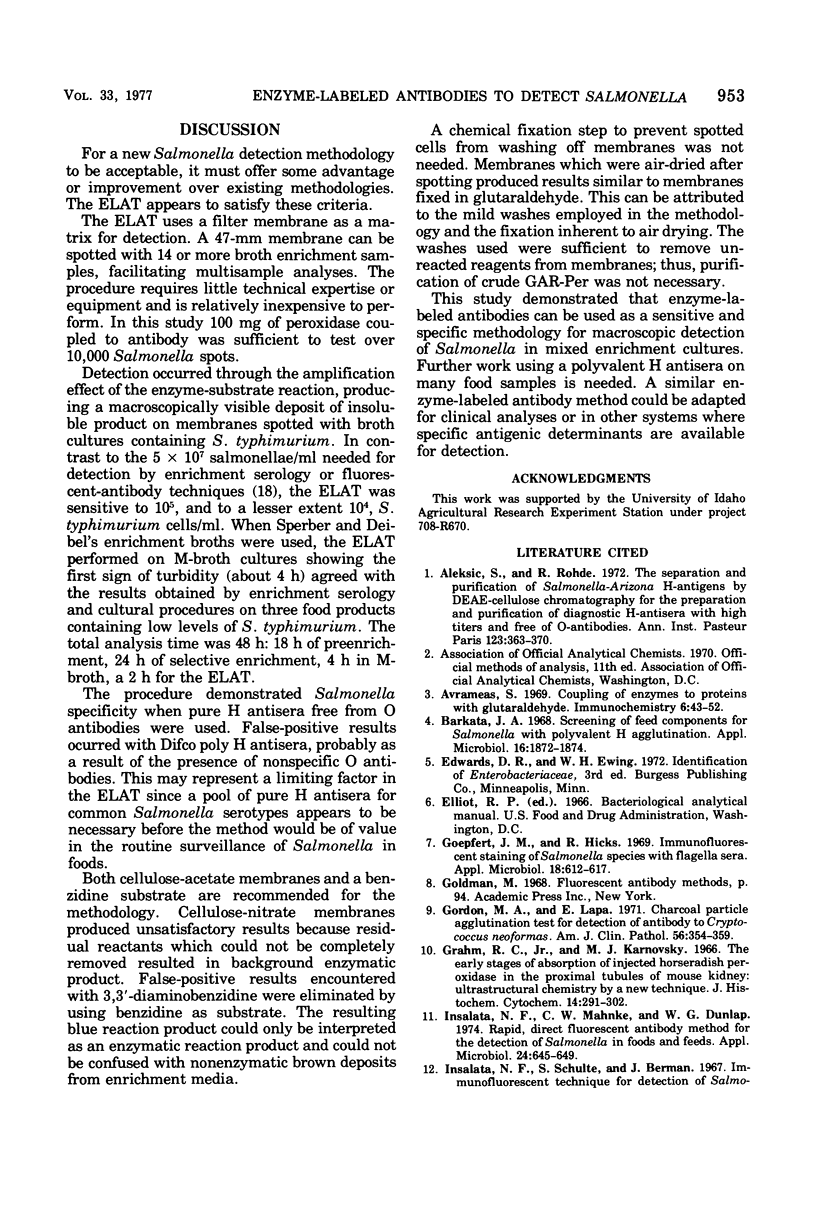Abstract
An indirect enzyme-labeled antibody technique (ELAT), in which Salmonella typhimurium was used as a model, was developed as a method to detect Salmonella in food samples. A cellulose-acetate membrane filter, the matrix for detection, was placed on a membrane-filter base and overlaid with a multiwelled lucite template. Mixed broth enrichment cultures were dispensed in the template wells, and cells were spotted onto the membrane via suction. After fixation, the membranes were immersed in rabbit anti-S. typhimurium flagella antibody, washed, immersed in goat anti-rabbit antibody conjugated to peroxidase, and washed. Exposure of membranes to the substrates 3,3'-diaminobenzidine or benzidine resulted in development of brown or blue macroscopic reaction products, respectively, on spots containing S. typhimurium. ELAT results agreed with those of enrichment serology and cultural procedures on three food products containing known levels of S. typhimurium. Because of the magnification effect of the enzyme-substrate reaction, fewer cells were needed for detection than with enrichment serology, thereby reducing the total analysis time. The ability to test 14 or more samples simultaneously on a 47-mm membrane filter would facilitate screening large number of samples. Pending the development of a pure H antisera pool for the common Salmonella serotypes free from O antibodies, the ELAT demonstrated potential as a Salmonella detection methodology.
Full text
PDF







Images in this article
Selected References
These references are in PubMed. This may not be the complete list of references from this article.
- Aleksić S., Rohde R. The separation and purification of "Salmonella-Arizona" H-antigens by the DEAE-cellulose column chromatography for the preparation of diagnostic H-antisera with high titres and free of O-antibodies. Ann Inst Pasteur (Paris) 1972 Sep;123(3):363–377. [PubMed] [Google Scholar]
- Avrameas S. Coupling of enzymes to proteins with glutaraldehyde. Use of the conjugates for the detection of antigens and antibodies. Immunochemistry. 1969 Jan;6(1):43–52. doi: 10.1016/0019-2791(69)90177-3. [DOI] [PubMed] [Google Scholar]
- Barkate J. A. Screening of feed components for Salmonella with polyvalent H agglutination. Appl Microbiol. 1968 Dec;16(12):1872–1874. doi: 10.1128/am.16.12.1872-1874.1968. [DOI] [PMC free article] [PubMed] [Google Scholar]
- Goepfert J. M., Hicks R. Immunofluorescent staining of Salmonella species with flagellar sera. Appl Microbiol. 1969 Oct;18(4):612–617. doi: 10.1128/am.18.4.612-617.1969. [DOI] [PMC free article] [PubMed] [Google Scholar]
- Gordon M. A., Lapa E. Charcoal particle agglutination test for detection of antibody to Cryptococcus neoformans: a preliminary report. Am J Clin Pathol. 1971 Sep;56(3):354–359. doi: 10.1093/ajcp/56.3.354. [DOI] [PubMed] [Google Scholar]
- Graham R. C., Jr, Karnovsky M. J. The early stages of absorption of injected horseradish peroxidase in the proximal tubules of mouse kidney: ultrastructural cytochemistry by a new technique. J Histochem Cytochem. 1966 Apr;14(4):291–302. doi: 10.1177/14.4.291. [DOI] [PubMed] [Google Scholar]
- Insalata N. F., Mahnke C. W., Dunlap W. G. Rapid, direct fluorescent-antibody method for the detection of salmonellae in food and feeds. Appl Microbiol. 1972 Oct;24(4):645–649. doi: 10.1128/am.24.4.645-649.1972. [DOI] [PMC free article] [PubMed] [Google Scholar]
- Insalata N. F., Schulte S. J., Berman J. H. Immunofluorescence technique for the detection of salmonellae in various foods. Appl Microbiol. 1967 Sep;15(5):1145–1149. doi: 10.1128/am.15.5.1145-1149.1967. [DOI] [PMC free article] [PubMed] [Google Scholar]
- Mohr H. K., Trenk H. L., Yeterian M. Comparison of fluorescent-antibody methods and enrichment serology for the detection of Salmonella. Appl Microbiol. 1974 Feb;27(2):324–328. doi: 10.1128/am.27.2.324-328.1974. [DOI] [PMC free article] [PubMed] [Google Scholar]
- Nakane P. K. Classifications of anterior pituitary cell types with immunoenzyme histochemistry. J Histochem Cytochem. 1970 Jan;18(1):9–20. doi: 10.1177/18.1.9. [DOI] [PubMed] [Google Scholar]
- Nakane P. K., Pierce G. B., Jr Enzyme-labeled antibodies for the light and electron microscopic localization of tissue antigens. J Cell Biol. 1967 May;33(2):307–318. doi: 10.1083/jcb.33.2.307. [DOI] [PMC free article] [PubMed] [Google Scholar]
- Reamer R. H., Hargrove R. E. Twenty-four-hour immunofluorescence technique for the detection of salmonellae in nonfat dry milk. Appl Microbiol. 1972 Jan;23(1):78–81. doi: 10.1128/am.23.1.78-81.1972. [DOI] [PMC free article] [PubMed] [Google Scholar]
- STRAUS W. FACTORS AFFECTING THE CYTOCHEMICAL REACTION OF PEROXIDASE WITH BENZIDINE AND THE STABILITY OF THE BLUE REACTION PRODUCT. J Histochem Cytochem. 1964 Jun;12:462–469. doi: 10.1177/12.6.462. [DOI] [PubMed] [Google Scholar]
- Sperber W. H., Deibel R. H. Accelerated procedure for Salmonella detection in dried foods and feeds involving only borth cultures and serological reactions. Appl Microbiol. 1969 Apr;17(4):533–539. doi: 10.1128/am.17.4.533-539.1969. [DOI] [PMC free article] [PubMed] [Google Scholar]
- Stafford W. F., 3rd, Yphantis D. A. Existence and inhibition of hydrolytic enzymes attacking paramyosin in myofibrillar extracts of Mercenaria mercenaria. Biochem Biophys Res Commun. 1972 Nov 1;49(3):848–854. doi: 10.1016/0006-291x(72)90488-3. [DOI] [PubMed] [Google Scholar]
- Ubertini T., Wilkie B. N., Noronha F. Use of horseradish peroxidase-labeled antibody for light and electron microscope localization of reovirus antigen. Appl Microbiol. 1971 Mar;21(3):534–538. doi: 10.1128/am.21.3.534-538.1971. [DOI] [PMC free article] [PubMed] [Google Scholar]
- Weber K., Osborn M. The reliability of molecular weight determinations by dodecyl sulfate-polyacrylamide gel electrophoresis. J Biol Chem. 1969 Aug 25;244(16):4406–4412. [PubMed] [Google Scholar]
- Wicker R., Avrameas S. Localization of virus antigens by enzyme-labelled antibodies. J Gen Virol. 1969 Jun;4(4):465–471. doi: 10.1099/0022-1317-4-4-465. [DOI] [PubMed] [Google Scholar]




